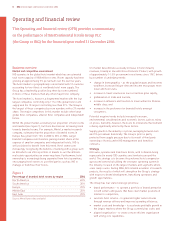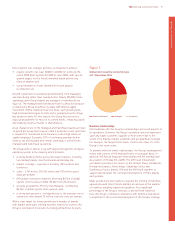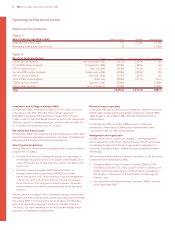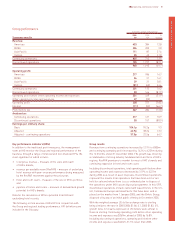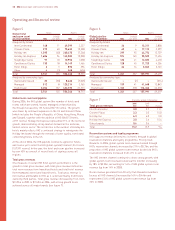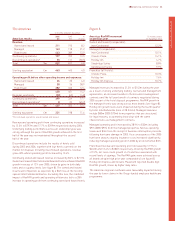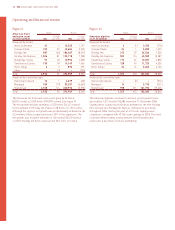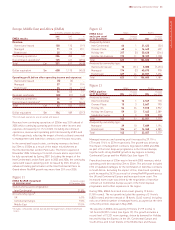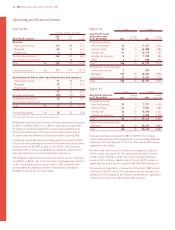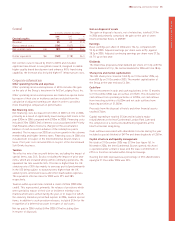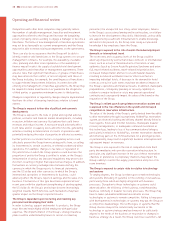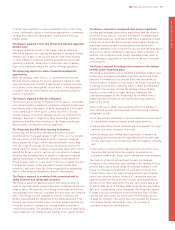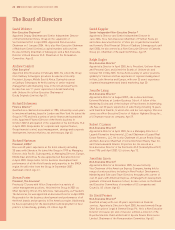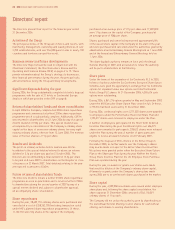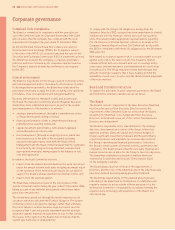Holiday Inn 2006 Annual Report Download - page 18
Download and view the complete annual report
Please find page 18 of the 2006 Holiday Inn annual report below. You can navigate through the pages in the report by either clicking on the pages listed below, or by using the keyword search tool below to find specific information within the annual report.
Figure 16
2006 2005
Net debt at 31 December £m £m
Borrowings (including derivatives):
Sterling 102 –
US Dollar 282 220
Euro 101 488
Other 48 71
Cash (including derivatives) (403) (686)
130 93
Excluding fair value of derivatives (net) 4(5)
Net debt 134 88
Average debt levels 92 700
Figure 17
2006 2005
Facilities at 31 December £m £m
Committed 1,157 1,163
Uncommitted 39 14
Total 1,196 1,177
Medium and long-term borrowing requirements at 31 December
2006 were met through a £1.1bn Syndicated Bank Facility which
matures in November 2009. Short-term borrowing requirements
were principally met from drawings under committed and
uncommitted bilateral loan facilities. At the year end, the Group
had £944m of committed facilities available for drawing.
The Syndicated Bank Facility contains two financial covenants, interest
cover and net debt/Earnings before Interest, Tax, Depreciation and
Amortisation (EBITDA). The Group is in compliance with both
covenants, neither of which is expected to represent a material
restriction on funding or investment policy in the foreseeable future.
Treasury management
Treasury policy is to manage financial risks that arise in relation to
underlying business needs. The activities of the treasury function
are carried out in accordance with Board approved policies and are
subject to regular audit. The treasury function does not operate as
a profit centre.
The treasury function seeks to reduce the financial risk of the
Group and manages liquidity to meet all foreseeable cash needs.
One of the primary objectives of the Group’s treasury risk
management policy is to mitigate the adverse impact of
movements in interest rates and foreign exchange rates.
The US dollar is the predominant currency of the Group’s
revenues and cash flows and movements in foreign exchange
rates, particularly the US dollar and euro, can affect the Group’s
reported profit, net assets and interest cover. To hedge this
translation exposure, the Group matches the currency of its debt
(either directly or via derivatives) to the currency of its net assets,
whilst maximising the amount of US dollars borrowed. A general
weakening of the US dollar (specifically a one cent rise in the
sterling: US dollar rate) would have reduced the Group’s profit
before tax for 2006 by an estimated £1m.
Foreign exchange transaction exposure is managed by the forward
purchase or sale of foreign currencies or the use of currency
options. Most significant exposures of the Group are in currencies
that are freely convertible.
Interest rate exposure is managed within parameters that stipulate
that fixed rate borrowings should normally account for no less than
25%, and no more than 75%, of net borrowings for each major
currency. This is achieved through the use of interest rate swaps
and options and forward rate agreements.
Credit risk on treasury transactions is minimised by operating
a policy on the investment of surplus funds that generally
restricts counterparties to those with an A credit rating or better,
or those providing adequate security. Limits are set for individual
counterparties. Most of the Group’s surplus funds are held in the
UK or US and there are no material funds where repatriation is
restricted as a result of foreign exchange regulations.
Figure 18
Interest risk profile of gross
debt for major currencies (including 2006 2005
derivatives) at 31 December %%
At fixed rates 53 36
At variable rates 47 64
Pensions
The Group operates two main schemes, the InterContinental Hotels
UK Pension Plan and the US-based InterContinental Hotels
Pension Plan. Including the unfunded element of the Plans, the
accounting deficits at 31 December 2006 were £29m and £33m
respectively.
Following the 2006 actuarial review of the UK Pension Plan,
the Group has agreed with the Plan Trustees to make a special
contribution of £40m. The special contribution will be paid over
three years with £20m in 2007 and £10m in each of 2008 and 2009.
The defined benefit section of the UK Plan is generally closed to new
members. The US Plan is closed to new members and pensionable
service no longer accrues for current employee members.
Employees
IHG employed an average of 11,456 people worldwide in the year
ended 31 December 2006.
The hospitality industry is a people-based business and as such
the Group’s HR strategy places great emphasis on the following:
•Leadership Strong leadership is central to IHG’s aim of
becoming one of the very best companies in the world. The
Company’s senior leadership programme involves the creation
of development plans for top performers, supported by
individual assessment and accredited business training and
incorporates long range succession planning;
•Development Across the Group, development training is
designed to increase the skills and knowledge of our employees
wherever they work. This year IHG launched employee
‘on-boarding programmes’ to assist new employees, in addition
to continued brand specific training and individual development
and coaching;
Operating and financial review
16 IHG Annual report and financial statements 2006


